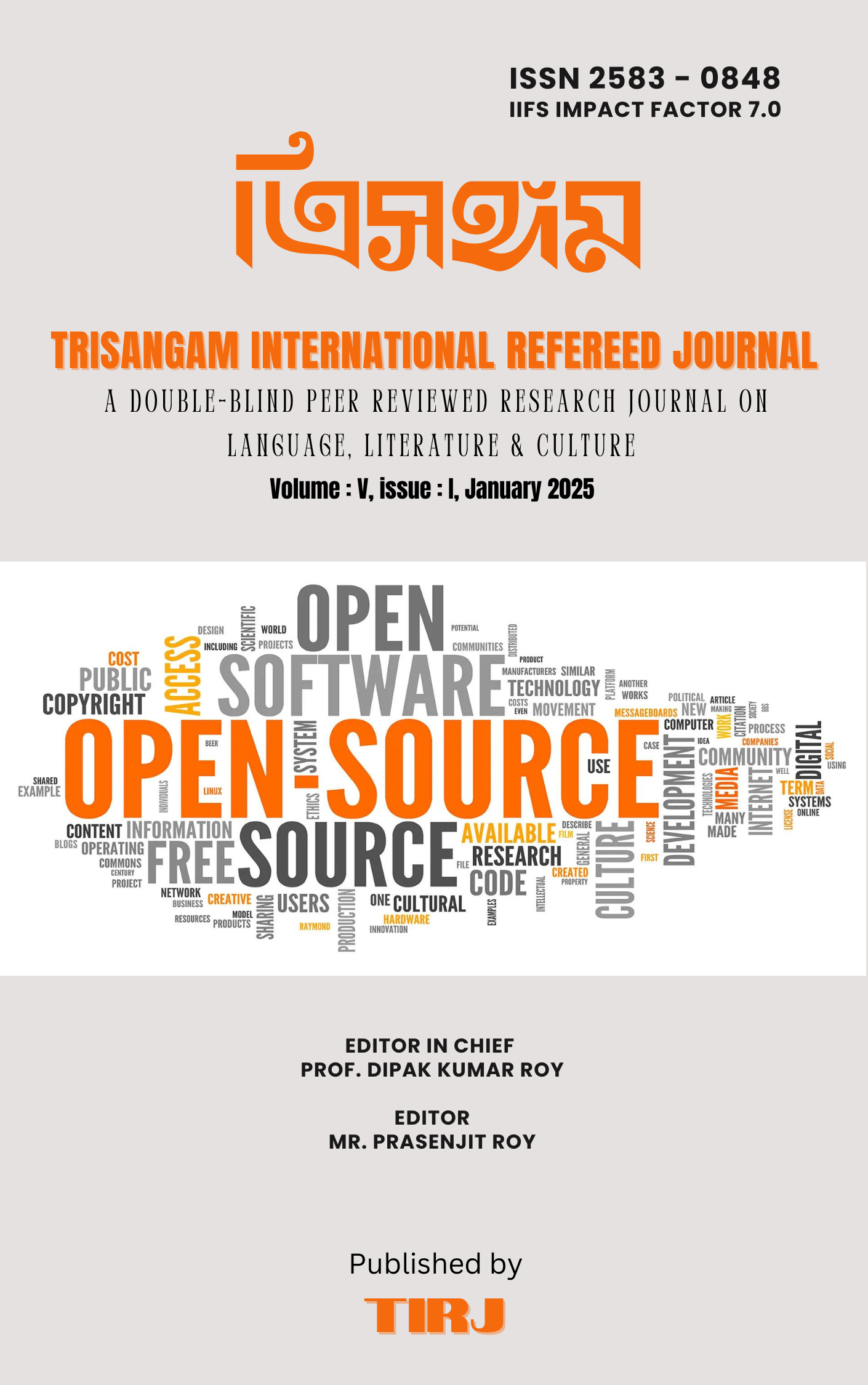Women’s Inner Voice in Folklore/ লোকসাহিত্যে নারীর অন্তঃকথা
Keywords:
- Folklore,
- Women,
- Domestic,
- Creative,
- Express,
- Desire,
- Dignity
Abstract
Folklore is a collage of the lived realities of ordinary people, providing valuable insights into the social position of women. In the earliest stages of human civilisation, women held a significant status in society. They actively participated alongside men in the struggle for survival and were industrious contributors. However, with the progression of civilisation, women’s autonomy and societal roles began to diminish, while male dominance steadily increased. Over time, the belief took root that women were incapable of participating in physically demanding activities. Consequently, men consolidated their authority, relegating women to subordinate roles confined within the domestic sphere. This confinement created an intense yearning within women to express their unspoken anguish. Much of Bengali folklore, predominantly oral in nature, was composed by women. Their oral literature naturally reflects their lived experiences, encompassing their struggles, sorrows, unfulfilled desires, and aspirations. Through their inherent creativity, women have crafted fairy tales, composed ritualistic bratakatha, soothing lullabies, and folk songs tied to various customs. Regardless of the themes, these works invariably carry the imprint of women’s personal experiences and inner reflections. Women’s repressed hopes and dreams found fulfilment through the female characters in their tales, where the heroines, despite enduring hardship and oppression—often at the hands of co-wives in a patriarchal society—reclaimed their dignity and fortune by the story’s end. Such narrative twists reveal the latent desires of women’s hearts. Similarly, the ritualistic rhymes of women’s vows (bratakatha) serve as reflections of their direct lived experiences. These verses express the hopes, aspirations, and contemplations of both unmarried and married women, capturing their achievements and disappointments. Across various branches of folklore, rural Bengali women have vividly and spontaneously articulated their life’s struggles, emotional turmoil, and suppressed sighs with masterful skill. Over time, as patriarchal oppression intensified, women—confined within the domestic sphere—grew vengeful, became aware of their individuality, and began to recognise the language of their subjugation. This awareness compelled them to portray their deprivations and grievances in the mirror of folklore, giving voice to their marginalised existence.
Downloads
References
১. দৈনিক আজাদী পত্রিকা, বাংলার লোকসাহিত্যে নারী-পুরুষ বৈষম্য— মাধব দীপ, শনিবার, ২৭ জানুয়ারি ২০১৮
২. চট্টোপাধ্যায়, হীরেন ও কৃষ্ণগোপাল রায় (সম্পাদনা), সাহিত্য-প্রবন্ধ : প্রবন্ধ-সাহিত্য, বাংলা প্রবাদ : বাঙালি জীবন, বিপ্লব চক্রবর্তী, কলকাতা-০৯, বঙ্গীয় সাহিত্য সংসদ, দ্বিতীয় পরিবর্ধিত সংস্করণ, দোলযাত্রা ২০০৯, পৃ. ৩০৯
৩. ভট্টাচার্য, শ্রী আশুতোষ, বাংলার লোকসাহিত্য (ষষ্ঠ খণ্ড : প্রবাদ), কলকাতা-৭৩, এ. মুখার্জী অ্যাণ্ড কো. প্রাঃ লিঃ, প্রথম সংস্করণ, ১৯৭২, পৃ. ৬৫
৪. বিশ্বাস, সুফল, লোকমনন : লোকসাহিত্য, কলকাতা-০৯, বঙ্গীয় সাহিত্য সংসদ, প্রথম প্রকাশ, রথযাত্রা ২০১৪, পৃ. ১৫৯
৫. ভট্টাচার্য, শ্রী আশুতোষ, বাংলার লোকসাহিত্য (ষষ্ঠ খণ্ড : প্রবাদ), কলকাতা-৭৩, এ. মুখার্জী অ্যাণ্ড কো. প্রাঃ লিঃ, প্রথম সংস্করণ, ১৯৭২, পৃ. ৫৬
৬. ভট্টাচার্য, শ্রী আশুতোষ, বাংলার লোকসাহিত্য (তৃতীয় খণ্ড : গীত ও নৃত্য), কলকাতা-০৯, ক্যালকাটা বুক হাউস, প্রথম সংস্করণ, ১৯৫৪, পৃ. ৯৯
৭. ভট্টাচার্য, শ্রী আশুতোষ, বাংলার লোকসাহিত্য (প্রথম খণ্ড : আলোচনা), কলকাতা-৭৩, এ. মুখার্জী অ্যাণ্ড কো. প্রাঃ লিঃ, পঞ্চম সংস্করণ, ২০০৪, পৃ. ১৯১
৮. ঠাকুর, অবনীন্দ্রনাথ, বাংলার ব্রত, কলকাতা-১৭, বিশ্বভারতী গ্রন্থন বিভাগ, পুণর্মুদ্রণ, জ্যৈষ্ঠ ১৪১৭, পৃ. ৪৭
৯. ভট্টাচার্য, শ্রী আশুতোষ, বাংলার লোকসাহিত্য (ষষ্ঠ খণ্ড : প্রবাদ), কলকাতা-৭৩, এ. মুখার্জী অ্যাণ্ড কো. প্রাঃ লিঃ, প্রথম সংস্করণ, ১৯৭২, পৃ. ৬১
১০. ঠাকুর, অবনীন্দ্রনাথ, বাংলার ব্রত, কলকাতা-১৭, বিশ্বভারতী গ্রন্থন বিভাগ, পুণর্মুদ্রণ, জ্যৈষ্ঠ ১৪১৭, পৃ. ৭
১১. মজুমদার, মানস, লোকসাহিত্য-পাঠ, কলকাতা-৭৩, দে'জ পাবলিশিং, প্রথম প্রকাশ, নভেম্বর ১৯৯৯, পৃ. ৫৩
১২. ভট্টাচার্য, শ্রী আশুতোষ, বাংলার লোকসাহিত্য (তৃতীয় খণ্ড : গীত ও নৃত্য), কলকাতা-০৯, ক্যালকাটা বুক হাউজ, প্রথম সংস্করণ, ১৯৫৪, পৃ. ২৮২
১৩. ভট্টাচার্য, শ্রী আশুতোষ, বাংলার লোকসাহিত্য (দ্বিতীয় খণ্ড : ছড়া), কলকাতা-০৯, ক্যালকাটা বুক হাউস, প্রথম প্রকাশ, ১৩৬৯, পৃ. ৩১১
১৪. তদেব, পৃ. ৩১৪
১৫. ভট্টাচার্য, শ্রী আশুতোষ, বাংলার লোকসাহিত্য (তৃতীয় খণ্ড : গীত ও নৃত্য), কলকাতা-০৯, ক্যালকাটা বুক হাউস, প্রথম সংস্করণ, ১৯৫৪, পৃ. ১০৩
১৬. তদেব, পৃ. ১০৬
১৭. ভট্টাচার্য, শ্রী আশুতোষ, বাংলার লোকসাহিত্য (দ্বিতীয় খণ্ড : ছড়া), কলকাতা-০৯, ক্যালকাটা বুক হাউস, প্রথম প্রকাশ, ১৩৬৯, পৃ. ৩১২
১৮. ভট্টাচার্য, শ্রী আশুতোষ, বাংলার লোকসাহিত্য (তৃতীয় খণ্ড : গীত ও নৃত্য), কলকাতা-০৯, ক্যালকাটা বুক হাউস, প্রথম সংস্করণ, ১৯৫৪, পৃ. ৫৪৬






